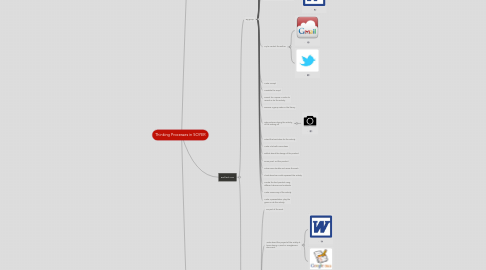
1. Read
1.1. Listen to Linda's explanation
1.2. Listen to Manel's explanation
1.3. Take notes and later read them
1.4. Read the activity in SAKAI
1.4.1. .
1.5. Read the papers
1.6. Read some parts in Spanish
1.7. Read information on the internet
1.7.1. .
1.7.2. .
1.7.3. .
1.8. Look for pictures in Flickr
1.8.1. .
1.9. Play the Gymkana
1.9.1. .
1.10. Take idas from the group
1.11. Read emails from the group
1.11.1. .
1.12. Read again and highlight the most important things
1.13. See other grooups work in the same activity
1.14. Look for examples on the internet
1.14.1. .
1.15. Ask for help in order to use some device
1.16. Read books
2. Reflect-Do
2.1. By group
2.1.1. Brainstorming
2.1.2. Select the way of representing
2.1.3. Look for materials
2.1.4. Select examples for using them in the activity
2.1.5. Decide the way of participation of each member of the group
2.1.6. Revise the work untill the moment
2.1.7. Redo part of the work in order to do it better
2.1.8. Present the final product to other groups
2.1.9. Try to understand their work
2.1.10. Express how we understand they work
2.1.11. Make a list of our guessings or ideas
2.1.12. Reflect what part of their work we don't understand
2.1.13. Divide the work
2.1.14. Write and organiza the topic in order to make the work easier
2.1.15. Reflect on the activity
2.1.16. Create a presentation
2.1.16.1. .
2.1.17. Do a Word or Google Document with the information
2.1.17.1. .
2.1.18. Try to contact the author
2.1.18.1. .
2.1.18.2. .
2.1.19. Make a script
2.1.20. Translate the script
2.1.21. Search for a space in order to record or do the activity
2.1.22. Reserve a group cabin in the library
2.1.23. Take pictures during the activity; of the making off
2.1.23.1. .
2.1.24. Select the best ideas for the activity
2.1.25. Make a list with more ideas
2.1.26. Reflect about the design of the product
2.1.27. Draw, print, cut the product
2.1.28. Solve some doubts and revise the work
2.1.29. Think about we could represent the activity
2.1.30. Create the final product using different devices and materials
2.1.31. Make a summary of the acticity
2.1.32. Make a presentation, play the game or do the activity
2.2. Individually
2.2.1. Do part of the work
2.2.2. Write about the project of the actiity at home doing a Word or GoogleDocs document
2.2.2.1. .
2.2.2.2. .
2.2.3. Record the presentation or videos
2.2.3.1. .
2.2.4. Reflect on the blog
2.2.4.1. .
2.2.5. Make a summary of the paper
2.2.6. Write emails to the group
2.2.6.1. .
2.2.7. Facilitator's motivation
2.2.8. Take pictures of the group
2.2.8.1. .
2.2.9. Edit videos
2.2.10. Upload videos in Youtube
2.2.10.1. .
2.2.11. Write the things we didn't understand
2.2.12. Write or do possible parts of the activity
2.2.13. Highlight the most useful part of the paper
2.2.14. Organize the papers
2.2.15. Redo part of the activity
2.2.16. Revise the work in order to look for spelling mistakes
2.2.16.1. .
3. Share
3.1. In class
3.1.1. Exchange our work with the other grooups
3.1.2. Share our experience with the class
3.1.3. Share the ideas with the whole class
3.1.4. Send and suggest ideas
3.1.5. Send the script of the presentation or activity ro Linda about our evaluation of the other groups
3.1.6. Discuss and do consenses about every step of the activity
3.2. Email
3.2.1. Share our ideas
3.2.2. Share the URL of the final product
3.2.3. Share thoughts, pictures, videos and the final product
3.3. Blog
3.3.1. .
3.3.1.1. Share the process of the activity
3.3.1.2. Share our reflection
3.3.1.3. Share our activity
3.3.1.4. Share the roles
3.3.1.5. Share our emotions
3.3.1.6. Share pictures
3.3.1.7. Share videos
3.3.1.8. Share the final product
3.3.1.9. Share slides
3.4. Other
3.4.1. Oral presentation
3.4.2. Upload the final product in Youtube or Slideshare
3.4.2.1. .
3.4.2.2. .
